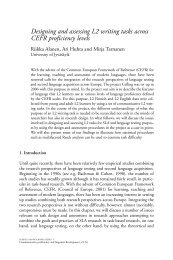BOOK OF ABSTRACTS - EUROSLA
BOOK OF ABSTRACTS - EUROSLA
BOOK OF ABSTRACTS - EUROSLA
You also want an ePaper? Increase the reach of your titles
YUMPU automatically turns print PDFs into web optimized ePapers that Google loves.
Adams, R. and Ross-Feldman (2008). Does Writing Influence Learner Attention to<br />
Form? In Belcher, D. & Hirvela, A. (Eds.). The oral/literate connection:<br />
Perspectives on L2 speaking/writing connections (pp. 243-265) Ann Arbor, MI:<br />
University of Michigan Press.<br />
Alegría de la Colina and M. P. García Mayo (2007). Attention to form across<br />
collaborative tasks by low proficiency learners in an EFL setting. In M. P.<br />
García Mayo (ed.) Investigating Tasks in Formal Language Learning. (pp. 91-<br />
116). Clevedon: Multilingual Matters.<br />
Fortune, A. (2005). Learners´ use of metalanguage in collaborative form-focused L2<br />
output tasks. Language Awareness, 14: 1, 21-38.<br />
Mehisto, P., D. Marsh, & M, Frigols. (2008). Uncovering CLIL: Content and<br />
Language Integrated Learning in Multilingual Education. Macmillan: Oxford.<br />
Philp, J., Walter, S. and Basturkmen, H. (2010). Peer interaction in the foreign<br />
language classroom: what factors foster a focus on form?. Language Awareness,<br />
19: 4, 261-279.<br />
Swain, M. (1998). Focus on form through conscious reflection. In C. Doughty & J.<br />
Williams (Eds.), Focus on Form in Classroom Second Language Acquisition<br />
(pp. 64-81). Cambridge: Cambridge University Press.<br />
Swain, M. and S. Lapkin. (2000). Task-based second language learning. The uses of<br />
the first language. Language Teaching Research 4(3): 251-274.<br />
Wajnryb, R. (1990). Grammar Dictation. Oxford: Oxford University Press.<br />
Collocational processing in an L2: The role of L1 knowledge and<br />
frequency of input<br />
Brent Wolter 1 and Henrik Gyllstad 2<br />
1 2<br />
Idaho State University, Lund University<br />
In the L1 mental lexicon, lexical items of different types and sizes are<br />
believed to be linked to each other in a systematic and efficient lexical<br />
network. In usage-based models of language acquisition, in terms of network<br />
growth, an essential factor is assumed to be frequency of input (Ellis 2002).<br />
However, when acquiring an L2, input may not always lead to acquisition,<br />
and the already existing L1 network is expected to have an influence on<br />
acquisition and processing (Ellis 2006; Wolter 2006; Wolter & Gyllstad, in<br />
press). In this study, we investigated the role that L2 frequency of input may<br />
play for the processing of collocations, and also in what way structures in the<br />
L1 may interfere with this processing. Based on frequencies in COCA (the<br />
Corpus of Contemporary American English), we compiled a list of L1congruent<br />
and L1-non-congruent English adjective + noun items, and<br />
subjected Swedish L1 learners of English to a timed acceptability judgment<br />
task. Results indicated that although the learners’ reaction time to noncongruent<br />
items was significantly slower than for congruent items,<br />
collocation frequency was significantly linked to processing speed for both<br />
item types. The implications of these results will be discussed.<br />
35



